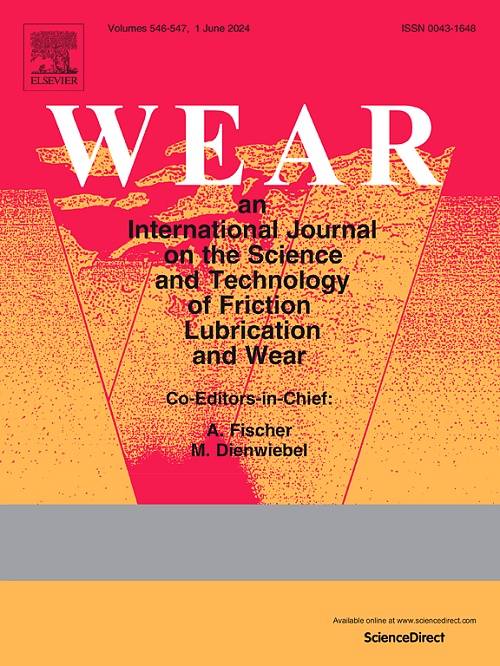Interfacial bonding and wear resistance of W, Mo, and MoS2 reinforced graphite/copper composites via microwave sintering
IF 6.1
1区 工程技术
Q1 ENGINEERING, MECHANICAL
引用次数: 0
Abstract
In the present work, W, Mo, and MoS2 reinforced graphite/copper composites were prepared using microwave sintering. By focusing on the copper matrix and graphite reinforcement, W and Mo elements were introduced into the copper matrix, while MoS2 was doped into the graphite. During sintering, carbide pinning phases and Cu-Mo-S transition layers were formed at the graphite/copper interface, enhancing the interfacial bonding between graphite and copper. The effects of sintering time on the microstructure and properties of the composites were investigated, including their tribological performance under varying friction loads and linear speeds. A sintering time of 60 min was observed to lead to composite materials with improved microstructural properties, specifically a higher density of pinning phases and Cu-Mo-S transition layers, as well as a uniform microstructure. Significant improvements were observed in density, hardness, electrical, and thermal conductivity. Under a friction load of 4 N and a sliding speed of 1.7 m/s, the wear rate of the composites was only 4.52 × 10−8 cm3 N−1 m−1. These findings provide a reference for improving the interface of graphite/copper composites and their application in the field of friction and wear.
微波烧结W、Mo和MoS2增强石墨/铜复合材料的界面结合和耐磨性
本文采用微波烧结法制备了W、Mo和MoS2增强石墨/铜复合材料。以铜基体和石墨增强为重点,在铜基体中引入W和Mo元素,在石墨中掺杂MoS2。烧结过程中,石墨/铜界面处形成碳化物钉钉相和Cu-Mo-S过渡层,增强了石墨与铜的界面结合。研究了烧结时间对复合材料显微组织和性能的影响,包括在不同摩擦载荷和线速度下的摩擦学性能。烧结时间为60 min时,复合材料的显微组织性能得到改善,特别是钉钉相和Cu-Mo-S过渡层密度更高,微观组织均匀。在密度、硬度、电导率和导热性方面观察到显著的改善。在4 N摩擦载荷和1.7 m/s滑动速度下,复合材料的磨损率仅为4.52 × 10−8 cm3 N−1 m−1。这些研究结果为改善石墨/铜复合材料的界面及在摩擦磨损领域的应用提供了参考。
本文章由计算机程序翻译,如有差异,请以英文原文为准。
求助全文
约1分钟内获得全文
求助全文
来源期刊

Wear
工程技术-材料科学:综合
CiteScore
8.80
自引率
8.00%
发文量
280
审稿时长
47 days
期刊介绍:
Wear journal is dedicated to the advancement of basic and applied knowledge concerning the nature of wear of materials. Broadly, topics of interest range from development of fundamental understanding of the mechanisms of wear to innovative solutions to practical engineering problems. Authors of experimental studies are expected to comment on the repeatability of the data, and whenever possible, conduct multiple measurements under similar testing conditions. Further, Wear embraces the highest standards of professional ethics, and the detection of matching content, either in written or graphical form, from other publications by the current authors or by others, may result in rejection.
 求助内容:
求助内容: 应助结果提醒方式:
应助结果提醒方式:


